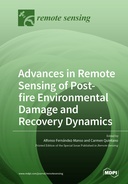Explore

Advances in Remote Sensing of Postfire Environmental Damage and Recovery Dynamics
0 Ungluers have
Faved this Work
Login to Fave
Understanding forest fire regimes involves characterizing spatial distribution, recurrence, intensity, seasonality, size, and severity. In recent years, knowledge of damage levels can be directly related to the environmental impact of fire and, at the same time, it is a valuable estimator of fire intensity, when the data about it are not available. Remote sensing may be seen as a tool to accurately assess burn severity and to predict the potential effects of forest fires on ecosystems, thus making the prediction of the regeneration of the plant community and the effects on ecosystems easier. This information is basic to facilitate decision-making in the post-fire management of fire-prone ecosystems. Nowadays, there has been intense research activity in relation to burned areas, burn severity, and vegetation regeneration because fires in many areas of the planet are becoming more severe and extensive, and their correct evaluation and follow-up is posing great challenges to current scientists. The current advances in remote sensing and related sciences will allow us to evaluate the damage with greater precision and to know with greater reliability the dynamics of recovery. This reprint contains studies on new remote sensing technologies, new sensors, data collections, and processing methodologies that can be successfully applied in burn severity mapping, vegetation recovery monitoring, and post-fire management of fire-prone ecosystems affected by large fires. We hope this book can help readers become more familiar with this knowledge and foster an increased interest in this field.
This book is included in DOAB.
Why read this book? Have your say.
You must be logged in to comment.
Rights Information
Are you the author or publisher of this work? If so, you can claim it as yours by registering as an Unglue.it rights holder.Downloads
This work has been downloaded 104 times via unglue.it ebook links.
- 104 - pdf (CC BY) at Unglue.it.
Keywords
- airborne laser scanner
- alpine treeline ecotone
- ALS
- Araucaria araucana
- arctic tundra fire
- burn severity
- burned areas detection
- C- and L-band SAR
- California
- canopy cover
- change detection
- char soil index
- classification thresholds
- composite burn index
- dNBR
- driving factors
- ecological disturbance
- ecosystem functioning
- EFAs
- energy balance
- Environmental science, engineering & technology
- evapotranspiration
- fire
- fire history
- fire impact
- fire management
- fire severity
- forest fire
- forest structure
- Fuzzy logic
- Google Earth Engine
- K-Means
- land surface albedo
- Land surface temperature
- Landsat
- Landsat 8 OLI
- Landsat-8 OLI
- LandTrendr
- LiDAR
- linear spectral mixing model
- mask region-based convolutional neural network
- Mediterranean
- mid-infrared burned index
- monoplotting
- NBR
- normalized burn ratio
- normalized difference vegetation index
- pine forests
- post-fire recovery
- post-fire restoration
- prescribed burns
- PROBA-V
- radar burn ratio
- random forest
- repeat photography
- RTM
- SAR
- SAR backscatter
- satellite image time-series
- Sentinel-2A
- shade fraction image
- small unmanned aircraft system
- small unmanned aircraft systems
- SSTCA
- structure-from-motion
- support vector machine
- SVR
- Technology, engineering, agriculture
- Technology: general issues
- time series
- time-series
- transfer learning model
- Tree canopy cover
- tree mortality
- UAS
- vegetation recovery
- VIIRS
- wildfire
- Wildfires
- wildland fire extent
- wildland fire severity
Links
DOI: 10.3390/books978-3-0365-5668-0Editions

